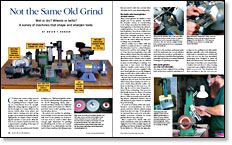Not the Same Old Grind
Wet or dry? Wheels or belts? A survey of machines that shape and sharpen tools.
Synopsis: Violin maker Brian T. Derber and his students review a representative sampling of types of grinders on the market. They tested each machine by grinding a broad sample of tools and found that there is no ideal grinder; each of the machines has idiosyncrasies that you need to take into account when choosing one. They found that dry double-arbor bench grinders are most common and handle the broadest variety of woodworking tools. They customized a belt-sander grinder and find it works as a low-cost alternative. Wet grinders work the best at grinding woodworking tools. The writer includes a side note on ways to dress the cutting surface of grinding stone.
Chances are, sooner or later, most of your cutting tools will need a grinding because a simple touchup on a benchstone won’t be enough. Maybe the cutting edge has a large nick, or the bevel angle is too steep. Whatever the reason, chisels, plane irons, planer and jointer knives, turning tools and carving gouges can be sharpened quickly with the right grinder. It’s simply a matter of matching the machine to your needs. What follows is not a head-to-head tool review, but a representative sampling of the types of grinders on the market.
For this survey, my students and I looked at Baldor’s No. 7306 bench grinder, Delta’s No. 23-700 Universal Wet/Dry grinder and No. 23-710 Sharpening Center (also a wet/dry machine), Grizzly’s No. G3105 belt and disc sander and Tormek’s No. 2004 SuperGrind water-cooled grinding system (see the photo above).
We tested each machine by grinding a broad sample of tools and discovered that with most of the grinders we looked at, tool rests were too small or didn’t allow enough angle adjustments for grinding woodworking tools. In short, we concluded that there is no ideal grinder and that each of these machines has idiosyncrasies that you need to take into account when choosing one for your sharpening needs.
Dry double-arbor bench grinders are most common
These bench grinders are familiar to most people and, in my opinion, can handle the broadest variety of woodworking tools. Today’s motorized dry double-arbor bench grinders evolved from the old handcranked grinders. You can find all sorts of bench grinders, from those cobbled from spare parts and used motors to expensive heavy-duty industrial machines, such as the Baldor No. 7306 with its 1⁄2-hp motor and 7-in.-dia. wheel. Wheel size and power ratings vary considerably.
Motors usually run at either 1,800 rpm (which is considered slow) or 3,450 rpm. Woodworkers look for a wheel diameter between 6 in. and 8 in. and a rating of 1⁄4 hp or 1⁄2 hp. Most bench grinders come with silicon-carbide wheels that will easily burn up any woodworking tool. You should replace these wheels with the softer, bonded aluminum-oxide wheels that are offered in many woodworking-tool catalogs. You may want to buy coarse- and fine-grit wheels to handle a wide variety of tools. Also, the stock tool rests supplied with most bench grinders are poorly designed. Many woodworkers either build a rest of their own or buy an aftermarket rest.
From Fine Woodworking #135
For the full article, download the PDF below:
Fine Woodworking Recommended Products

Olfa Knife

Estwing Dead-Blow Mallet

Blackwing Pencils






















Log in or create an account to post a comment.
Sign up Log in